In the age of laser scanning and data acquisition, one of the biggest shortcomings of sim racing titles in recent years has been struggling to keep up with the ever-changing world of sports car racing.
When I first joined iRacing, there was just one GT car in the service: the GT1 Corvette C6R. It took several years for the Ford GT2 to be released, and a few more years until GT3s slowly started to find their way into the sim en masse.
You could blame it on the fast-moving landscape of global sports car racing and regulations. Or the cost and time to license, scan, and develop cars and their increasingly complex technologies in a virtual environment. Or even the potential reluctance of manufacturers to hand over the details about their multi-million dollar investments to game companies.
In any case, many of the sports cars in iRacing and other sims have become outdated, and several multi-class iRacing series feature lineups that either raced together more than five years ago or never competed on-track with one another in the real world.
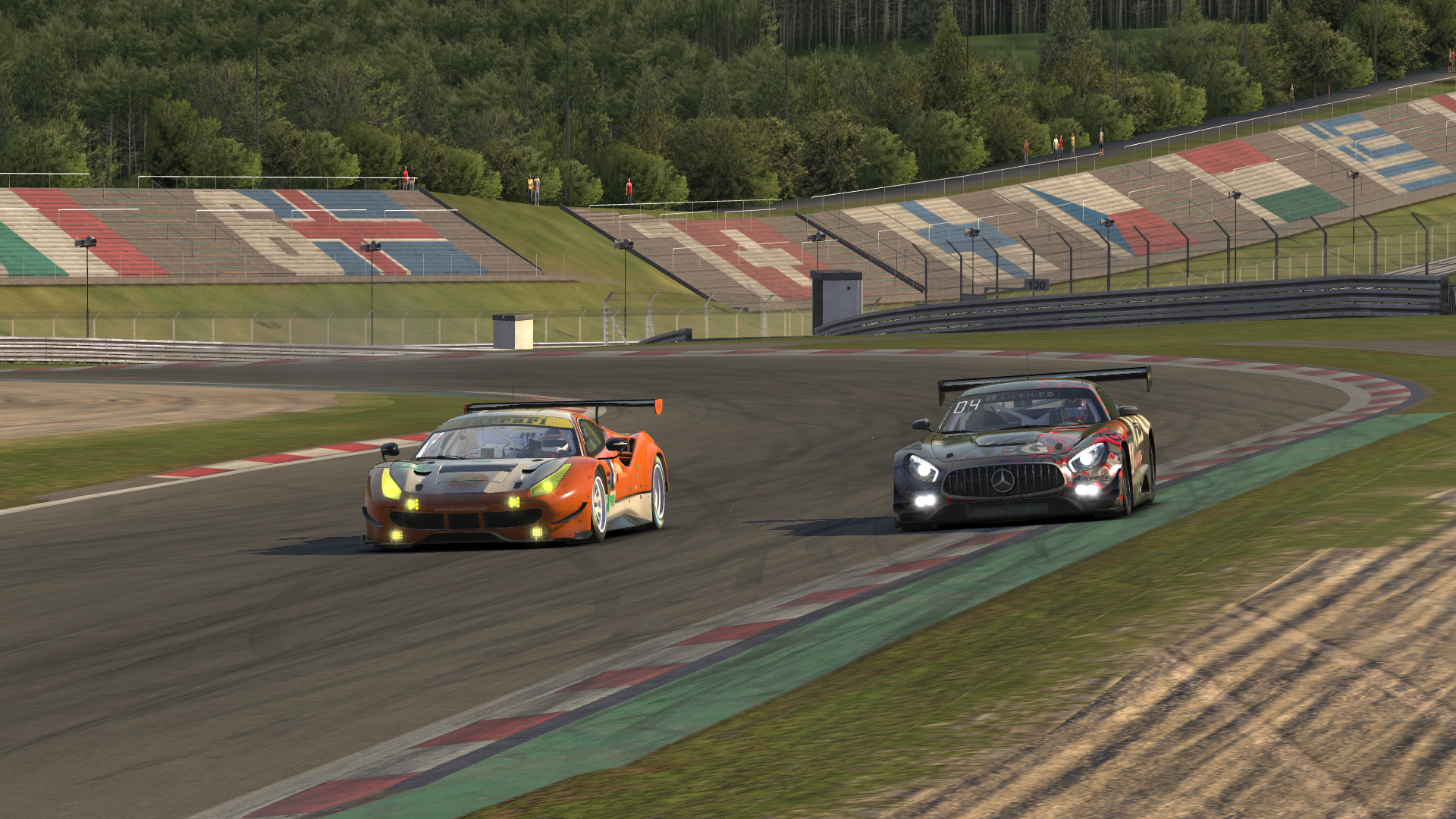
A Ferrari GTE and Mercedes GT3 — one combo that can be found on track together in the real world.
One series affected by this problem has been the officially sanctioned IMSA Sportscar Championship. Its prototype has hardly ever matched the most current version, the GT Le Mans class has either been represented by its Ford GT ancestor or nothing at all, and a mix of GT3s and the Ruf C-Spec or Porsche 911 GT3 Cup cars have represented some amalgam of the past and present GT Daytona class.
Earlier this summer, though, one of those problems was solved. In a somewhat unanticipated move given the usual rate of development, iRacing released both the modern Ferrari 488 and Ford GT cars, which compete globally in the GTE class and in IMSA’s GT Le Mans class.
With both of IMSA’s GT classes represented by current cars and the Daytona Prototype just one year out of date, the series has suddenly become one of the most up-to-date on iRacing’s road racing ladder.
The Shakedown
When the new cars were released, I wasn’t sure what to expect from them. My only reference for how a GTE car handled was from their predecessor, the GT2 Ford GT. I hated the way it drove: often plowing like a bulldozer, bouncing over bumps and kerbs, and generally tough to set up and drive. Surely the new cars wouldn’t be that bad, right?
Indeed they were not. In fact, it’s as if they took those weaknesses and made them strengths. In my first test drive, I noticed how responsive both cars were. They handled well, almost unlike GT cars at all. In fact, the only giveaway that they weren’t prototypes was the weight I felt in the steering wheel.
Like the old Ford GT, these cars have no anti-lock brakes. However, they do have traction control, which makes it easier to control their fast acceleration on corner exit.
So far, I have found the Ferrari a bit easier and more intuitive to drive because it tends to behave more like a typical GT car. It does have plenty of the downforce that defines modern GTEs, but it punishes overdriving like any other GT.
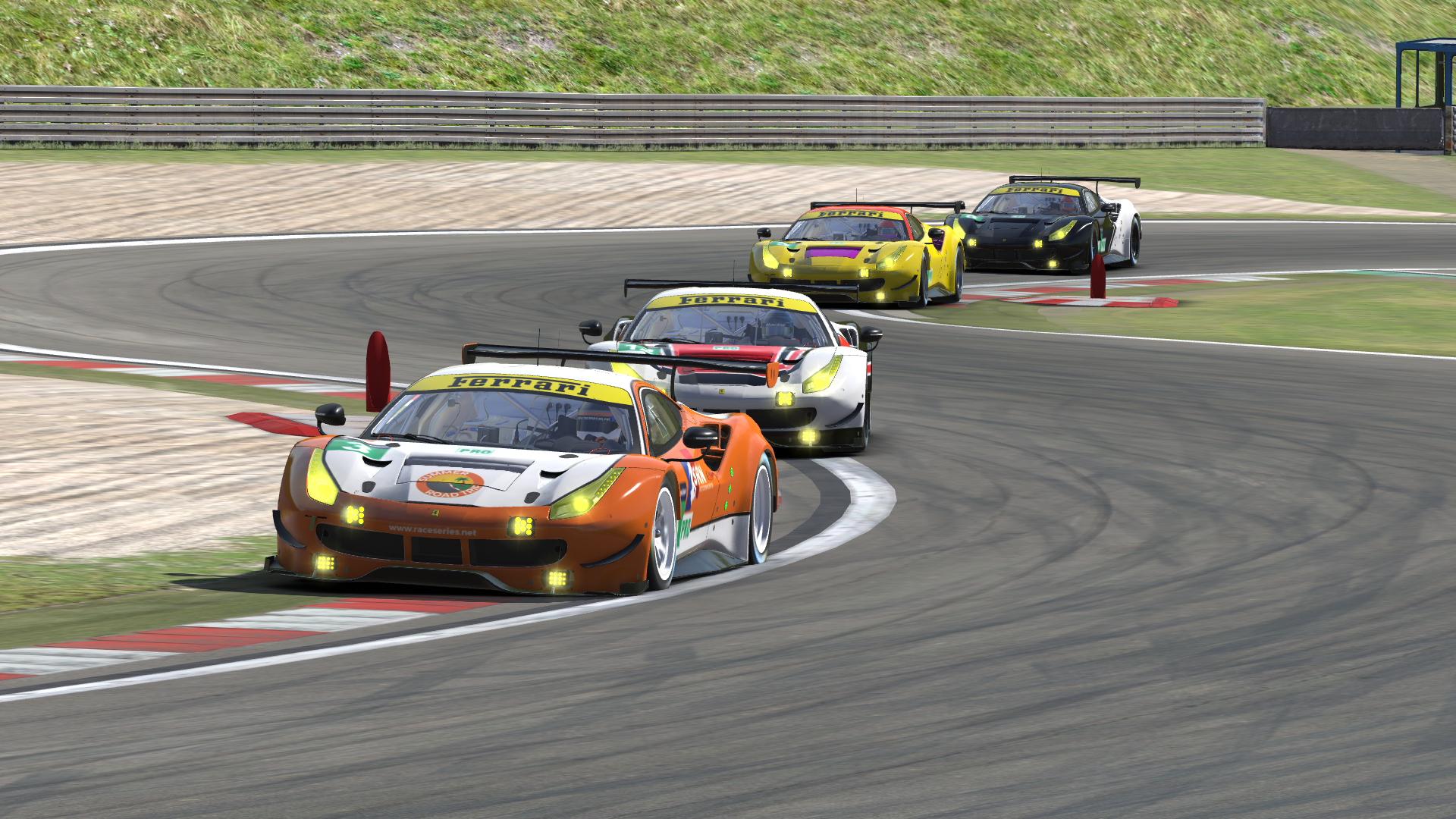
Leading a pack of Ferraris through the chicane.
The Ford, on the other hand, has dodged comparisons — or accusations, perhaps — of being a prototype in GT clothing, and after driving the virtual version of it, I can see why. The lower seating position gives it a prototype feel, and it seems to excel with faster corners and maintaining momentum.
The differences are also noticeable in the garage. When you’re changing ride heights, you’ll adjust the traditional spring perch offset on the Ferrari while the Ford uses torsion bars — something quite different for a GT car but not uncommon on a prototype or open-wheeler.
Those differences aside, both cars seemed to respond well to my setup adjustments, and for cars like this, you’ll definitely want to know your way around a setup if you’re planning to race them. As good as professionally made setups are, differences in driving styles and personal preferences require some tweaks.
The changing weather and track conditions from race to race also make it important to correctly adjust the setup, and these cars carry consequences for getting it wrong — more on that a bit later.
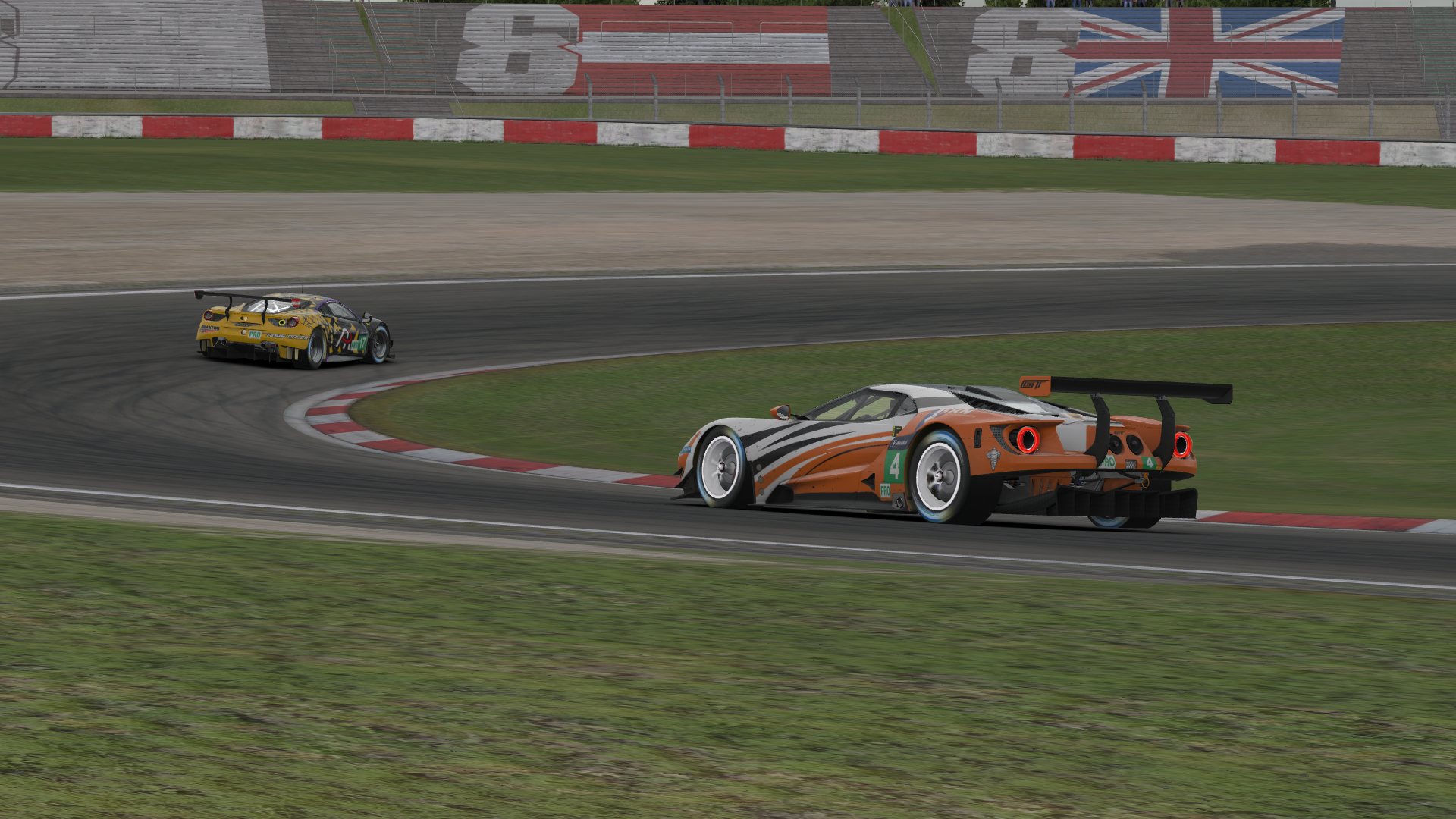
Ford chases Ferrari through the Dunlop Kehre.
GTE Cup?
Prior to this season, IMSA was relatively popular for a B-class series, with multiple official timeslots per day and participation distributed well among all three classes.
The two new GTE cars have sparked huge interest in the series, with nearly every road racer worth his salt coming in to try them out. Almost every time slot so far this season has gone official, so at least until the newness wears off, finding a race shouldn’t be a problem.
If you’re looking for a good multi-class race, though, this series may not be the place to find it. The popularity of the new cars has created a noticeable imbalance in participation. Races tend to be dominated by GTEs, often with just a handful of prototypes or GT3s in the top split and few to none of those classes in lower splits.
In addition, most weeks use 45-minute race lengths, which isn’t enough time to see many of the other class of cars given their limited pace differences — in my races at the Nurburgring last week, the three class polesitters were never separated by more than 8 seconds.
Those speed similarities can create some uncomfortable overlap between the slow drivers of one class and the fast ones of another. Slow Daytona Prototype drivers seem particularly vulnerable to this, and in a couple of my races, the GTE field caught those DPs, who generally yielded the position without much of a fight.
There is plenty of speed disparity among the GTE drivers as well, which tells me that these cars are easy to drive — at least compared to the likes of the V8 Supercar — but tough to drive fast. Indeed, turning laps in these cars is relatively effortless, but finding tenths and seconds is a much greater challenge.
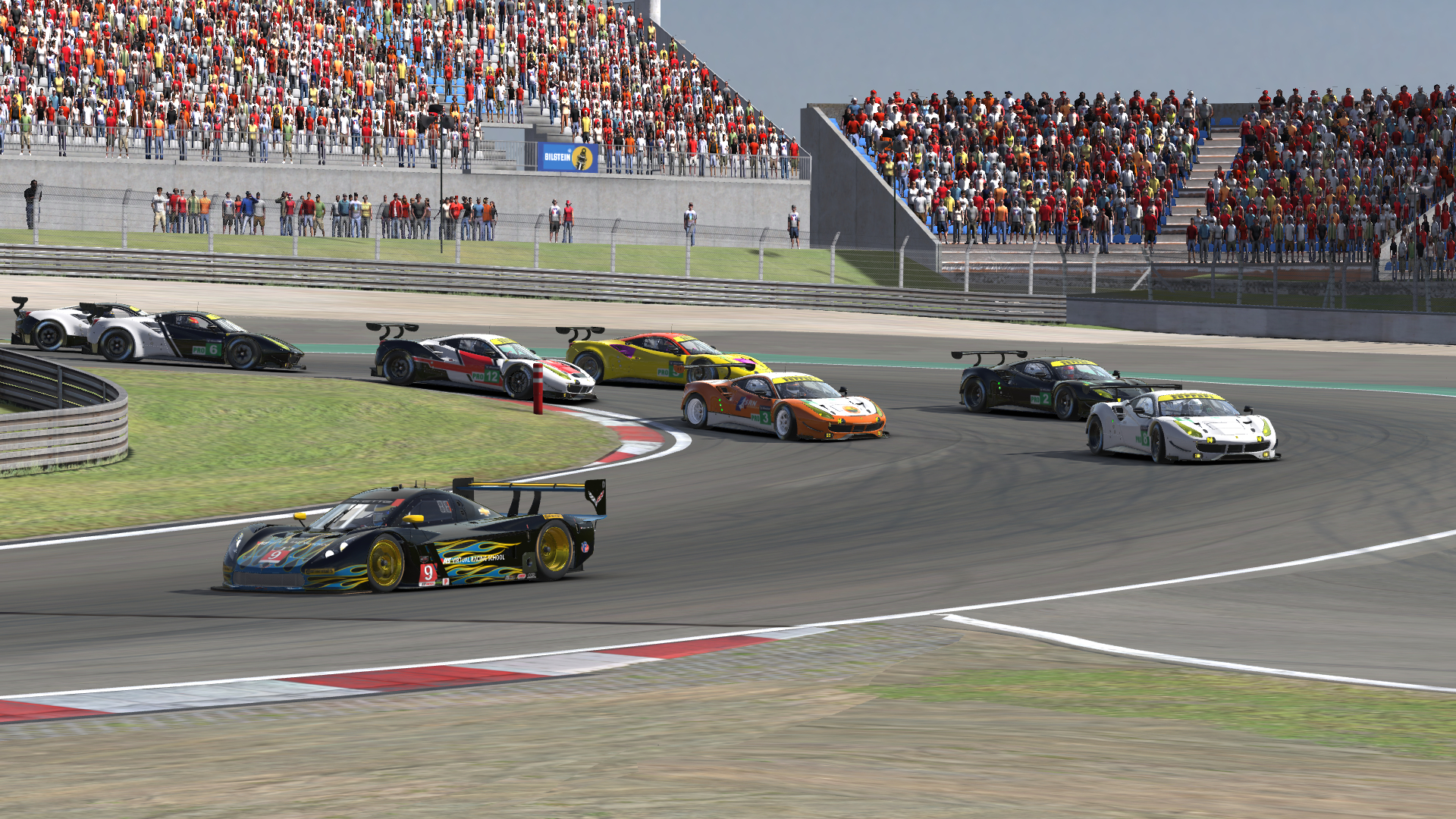
A lone prototype leads a field of GTEs through turn 1.
Forza Ferrari
I began the week in the Ferrari, largely because it was the car I was the most comfortable driving and the one I knew best after running a couple stints in the 24 Hours of Le Mans last month, albeit at a safe and somewhat slow pace.
In my first race of the week on Tuesday evening, I narrowly won the pole but didn’t even hold the lead through turn 1 on the first lap. The second-place starter passed me at the start, and although I stayed close to him for the first eight laps or so, after that, he pulled away as if he found a turbo boost button in the car.
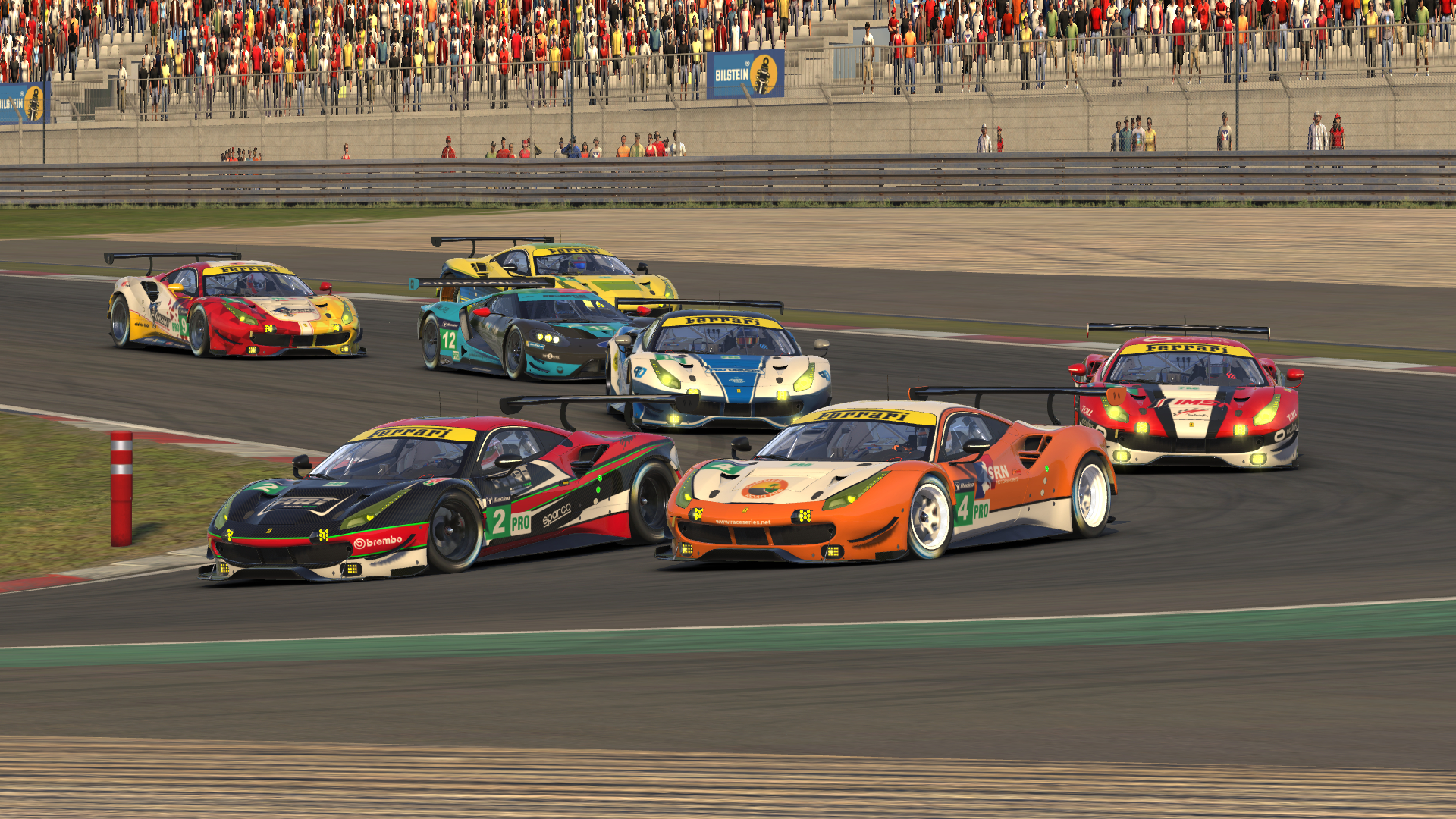
Losing the lead in the first corner of my first race.
Frustratingly, I was running consistent lap times just two tenths off my best lap of the race. That simply meant that my opponent was equally as consistent but a tick quicker than me.
By the middle of the race, I was in no-man’s land, with growing gaps to the leader ahead and the rest of the GTE field behind. From there, I brought the car home incident-free for the first time all season. While I lost a few seconds in the closing laps waiting patiently behind a pair of battling GT3s, I was still solidly in second place at the finish.
IMSA Sportscar Championship - Race 1
Tuesday, July 11 at 6:45 pm EDT • Strength of Field: 3044| Finish | Start | Interval | Laps Led | Fastest Lap | Incidents | Points | iRating | Safety Rating |
|---|---|---|---|---|---|---|---|---|
| 2 | 1 | -10.595 sec. | 0 | 1:49.234 | 0 | 153 | 4571 (+38) | A 3.69 (+0.30) |
Later that night, I did another race that got off to a similar start. After winning the pole, I dropped two spots before the first turn. This time, though, I managed to hang with the leaders — one Ford and one Ferrari — and found myself in the middle of an exciting three-car race.
With five laps to go, I was still in the hunt. Although the leader pulled away during the pit stops, I suspected he hadn’t taken enough fuel. And I was reeling in the second-place car, with whom I’d had some contact earlier in the race after he chopped across my nose entering the tight first turn.
Unfortunately, I never got to see how that potential battle for the win might end. My electricity flickered off for the first time ever while racing, dooming me to a DNF. Ironically, I’ve raced in ice storms and thunderstorms without a problem, but I was done in by an apparently random flicker on a clear night in July.
IMSA Sportscar Championship - Race 2
Tuesday, July 11 at 8:45 pm EDT • Strength of Field: 1902| Finish | Start | Interval | Laps Led | Fastest Lap | Incidents | Points | iRating | Safety Rating |
|---|---|---|---|---|---|---|---|---|
| 19 | 1 | -6 laps | 0 | 1:51.694 | 7 | 42 | 4481 (-90) | A 3.57 (-0.12) |
One More Try
Although I had planned to run just two races in the Ferrari before moving on to the Ford, I couldn’t stop after such an unsatisfying ending. So the following night, I hopped in the Ferrari again and found a strong field, including the runaway winner from my first race.
This time, I qualified in 3rd and managed to hold that position early on. Otherwise, the early laps had a similar feel; the leaders slowly pulled away while I ran consistent lap times a few tenths off of my best lap.
I couldn’t cruise home without a fight, though. The driver that qualified just behind me on the grid was shuffled back at the start but managed to reclaim those lost positions and catch me by the pit stops.
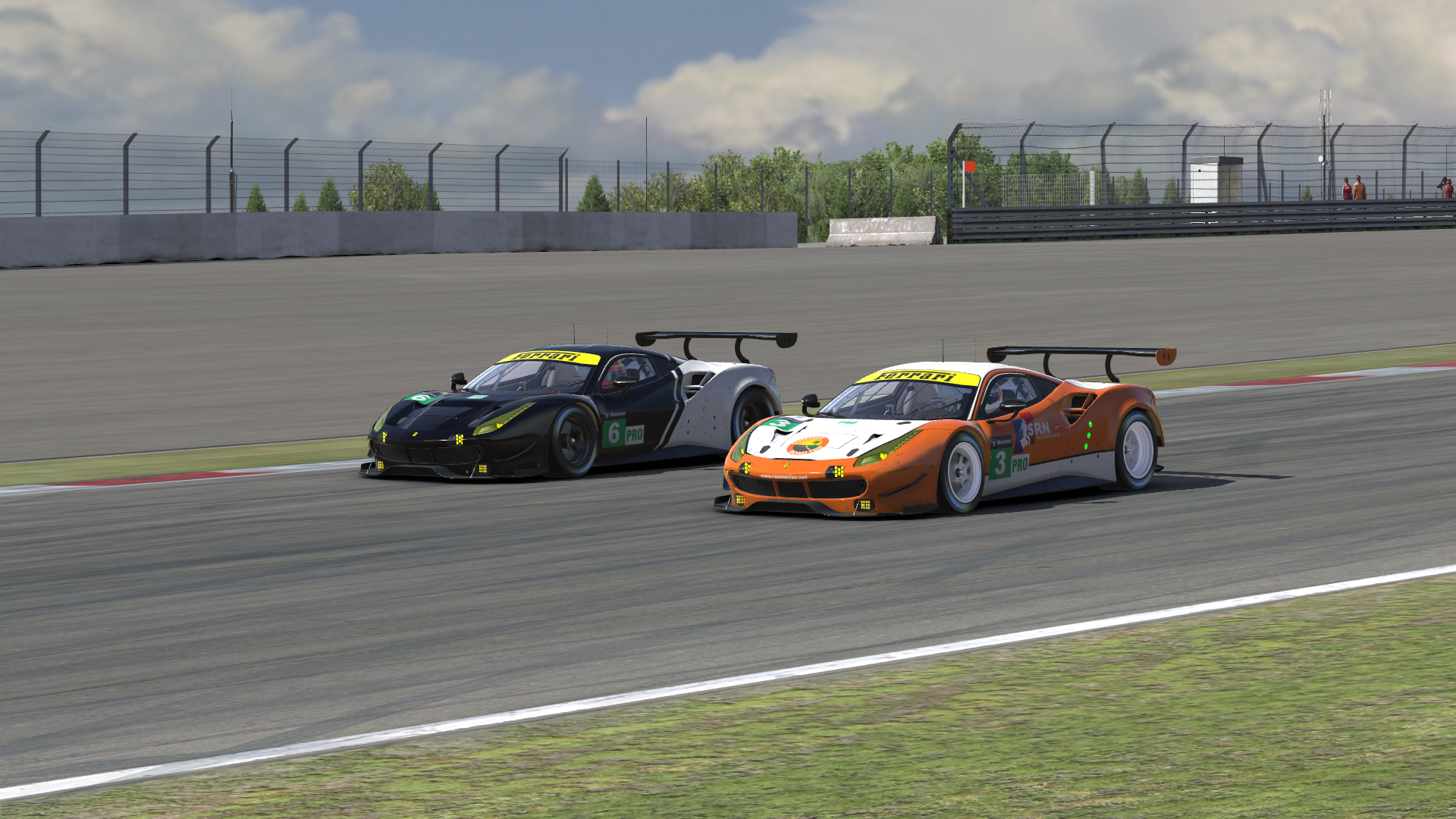
Battling for third place after the pit stops.
Exiting the pits, I overdrove turn 1 and let him get alongside me. Three turns later, he was ahead and pulling away. Given his pace, I expected he would catch me eventually, but I hoped I could hold him off for a bit longer.
However, warmer weather in this race meant that for the first time all week, I was noticing the effects of tire wear. I’m not sure whether my opponent had less wear or was just quicker, but either way, there was no keeping up once get got past me.
I wound up in fourth place with a slightly lower points haul than in my first race but modest iRating and safety rating gains to show for my efforts.
IMSA Sportscar Championship - Race 3
Wednesday, July 12 at 6:45 pm EDT • Strength of Field: 3138| Finish | Start | Interval | Laps Led | Fastest Lap | Incidents | Points | iRating | Safety Rating |
|---|---|---|---|---|---|---|---|---|
| 4 | 3 | -11.644 sec. | 0 | 1:50.846 | 4 | 143 | 4503 (+22) | A 3.66 (+0.09) |
Spin City
In its short tenure on iRacing, the new Ford may have gained something of a bad reputation, perhaps as a subconscious homage to its widely maligned predecessor.
Other drivers noticed that the new Ford is apparently more easily damaged from kerb strikes and contact, even despite recent patches from iRacing to lessen that likelihood. Its lack of top-end speed compared to the Ferrari also made it the less-popular choice for its debut race in the 24 Hours of Le Mans.
Since then, for drivers like me who drove the Ferrari at Le Mans, it’s been easier to stick with that car instead of switching to a different one. But in the interest of a fair comparison, I couldn’t end my week without stepping into the UFO-like cockpit of the Ford GT for a race.
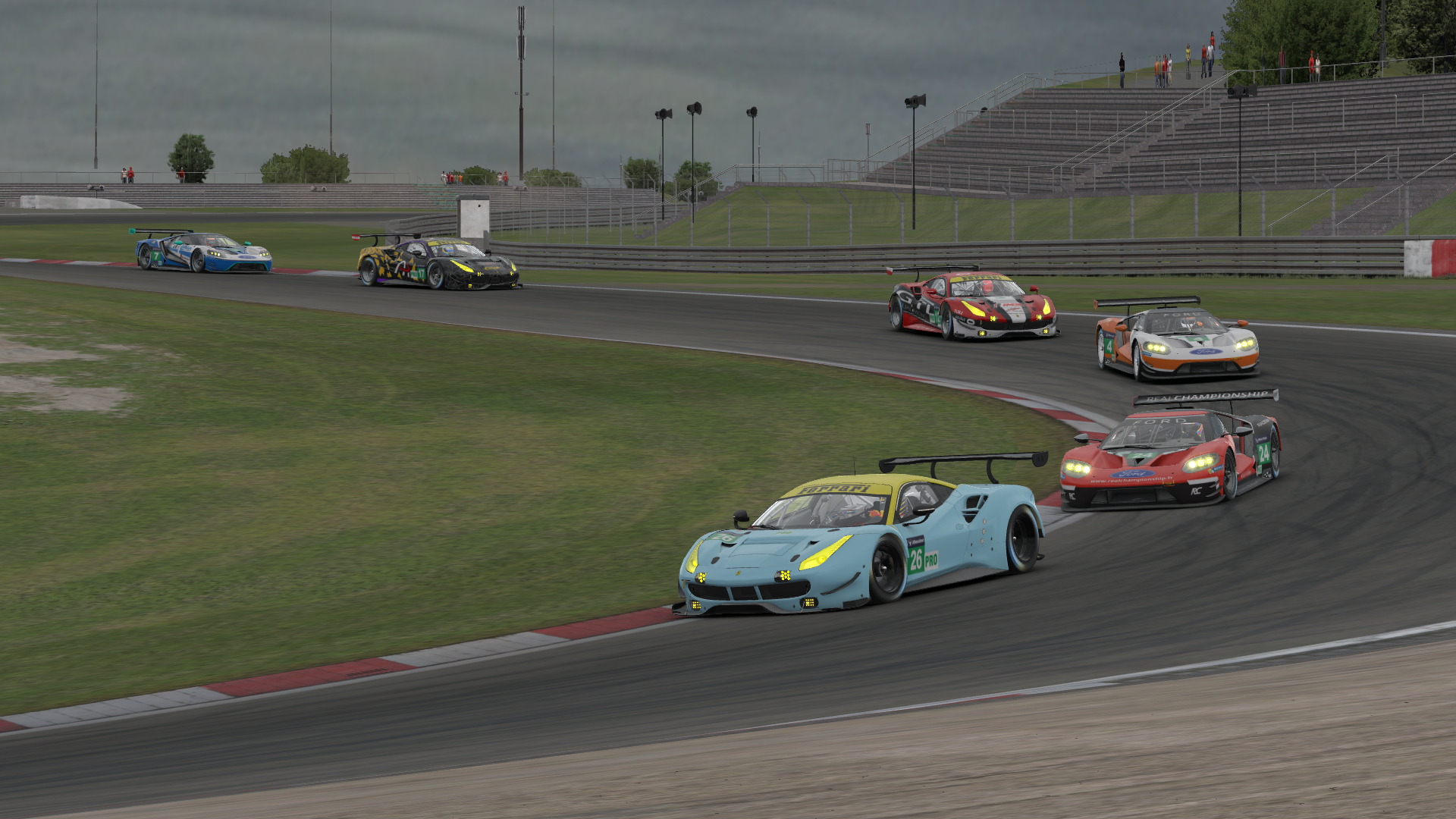
Part of the GTE field heads through the Ford Kurve on lap 1.
If I was going to find success in that car, I’d have to do it in the strongest field I saw all week. The talent level showed, as I qualified just seventh on the grid. Worse still for a Ford driver, the race weather was cool and overcast, which gave the track extra grip that I expected would help the Ferraris close the speed gap in high-speed corners.
I figured that the grippy weather would give the cars a bit of extra oversteer, so I removed some rake in an attempt to account for the track conditions. Early in the race, it was apparent that other drivers didn’t make that adjustment — or didn’t make enough of one.
In the opening laps, several cars around me spun or ran off-track. The quick left-right Ford Kurve complex seemed to be calamity corner, and on lap 6, it even caught me off-guard. While watching the Ferrari behind me fill my mirrors, my car suddenly slid sideways through that corner.
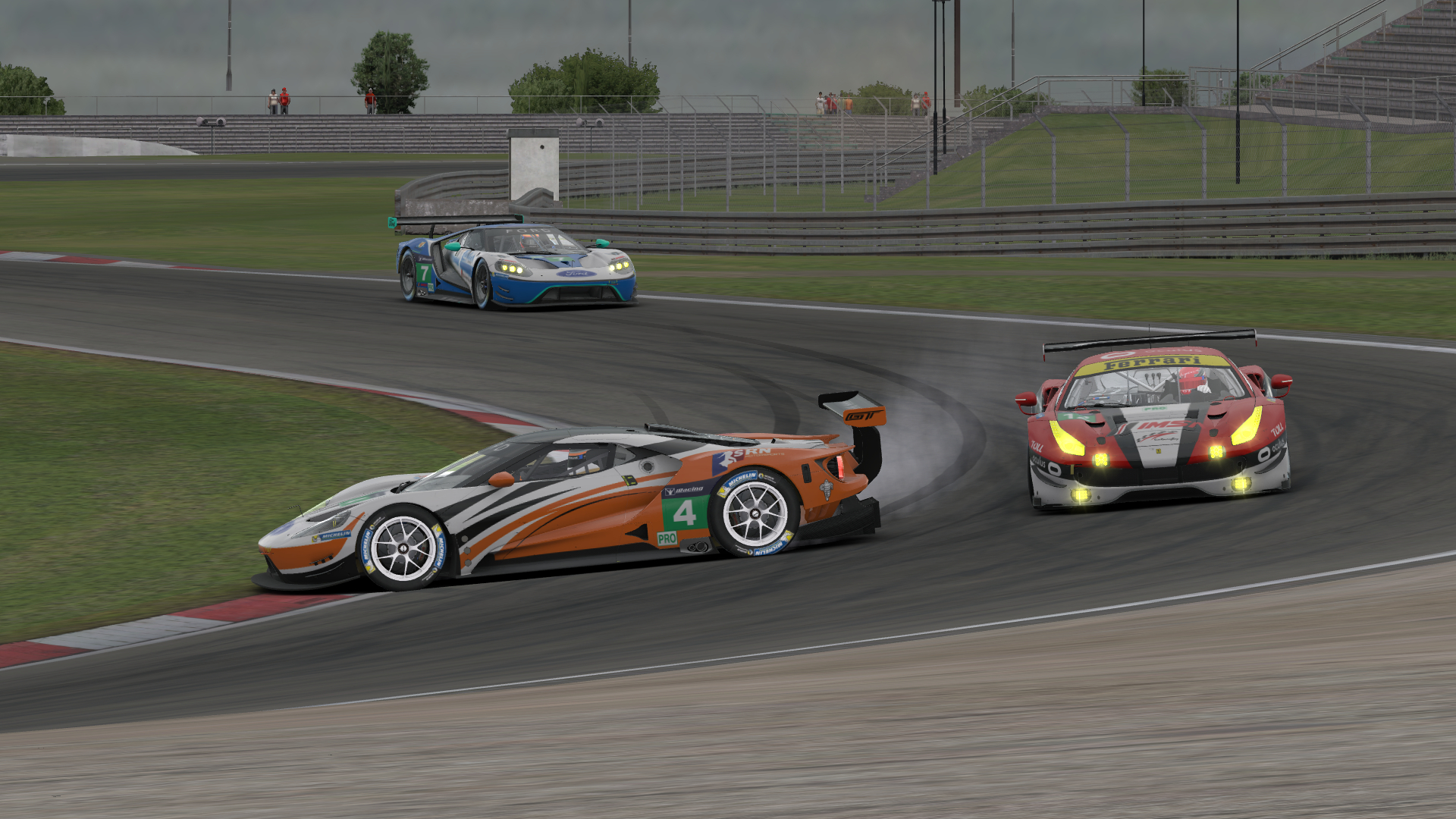
Spinning in the Ford Kurve while the Ferrari behind avoids me.
Thankfully, the cars behind avoided me and I got onto the grass and going again without a problem. However, it highlighted the tricky nature of a grippy track. In the laps that followed, I felt the car nearly get out from under me again several times, and a few cars ahead of me had incidents of their own.
After dropping as low as 11th place, I began to climb back through the Ferrari-dominated field. That clued me into one disadvantage of the Ford: Its comparative lack of top speed makes passing difficult, and largely confined to braking zones and corners.
I did make a few solid passes in these areas, but I gained more positions simply due to the mistakes around me. I also survived a close call when two Ferraris ahead of me made contact and one nearly spun into the side of my car.
After the pit stops, I found myself in sixth place and on the bumper of a Ferrari ahead of me that had been held up while lapping a GT3 car. In the closing laps, his pace was slightly quicker and he held me off to earn a top-five while I finished in sixth.
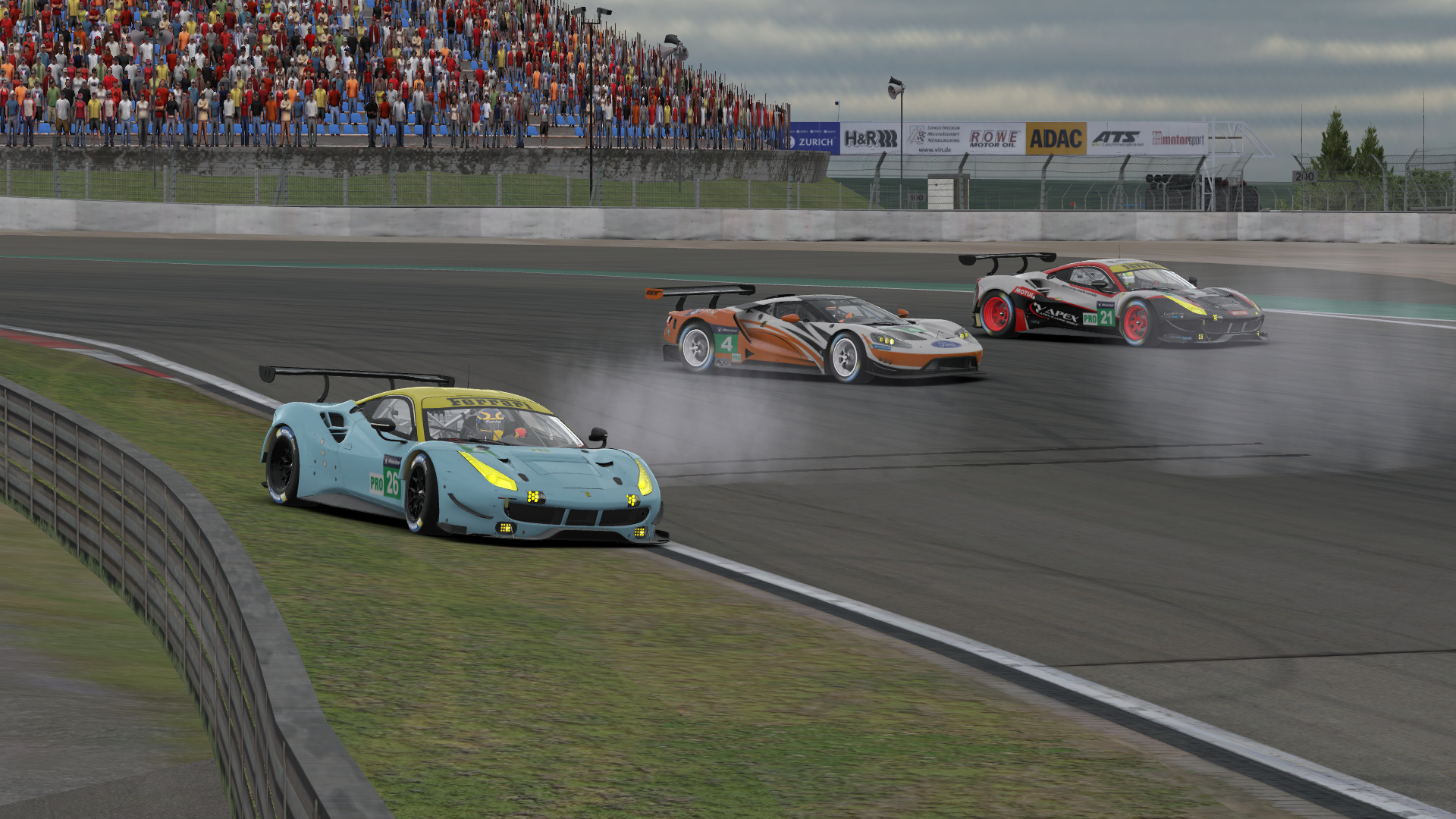
Passing a Ferrari exiting turn 1 while another Ferrari is spun to the inside.
IMSA Sportscar Championship - Race 4
Thursday, July 13 at 6:45 pm EDT • Strength of Field: 3236| Finish | Start | Interval | Laps Led | Fastest Lap | Incidents | Points | iRating | Safety Rating |
|---|---|---|---|---|---|---|---|---|
| 6 | 7 | -32.989 sec. | 0 | 1:48.662 | 2 | 142 | 4519 (+16) | A 3.83 (+0.17) |
Take Your Pick
So how do the Ferrari and Ford compare?
Overall, the balance of performance between the cars seems quite good around an intermediate — i.e., not Le Mans — circuit. From my initial testing laps through this week’s practices and races, my pace in both cars was similar, and I found myself competitive with drivers around my iRating who were running the opposite car.
Putting aside any lingering issues with the Ford being more easily damaged, I’d say the decision can and should come down to personal preference.
As a traditional GT driver, the Ferrari suites my driving style better and reacts the way I would expect. In the Ford, I struggled a bit to get comfortable, particularly with braking for corners and accelerating off of them.
That’s not the case for everyone, though. I suspect that other drivers, particularly those accustomed to driving open-wheelers and prototypes, will feel more at home in the Ford.
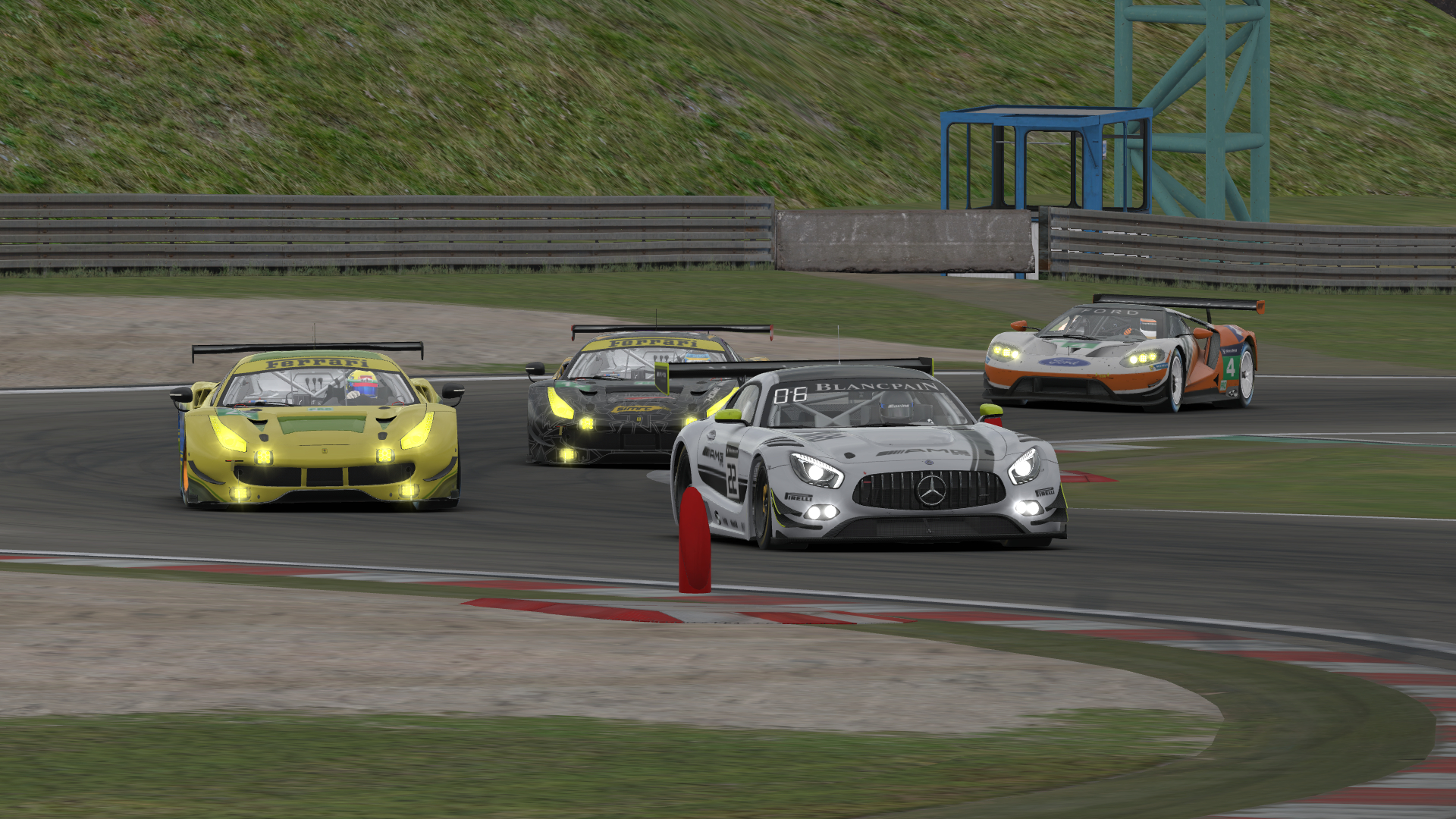
A group of GTEs approaches GT3 traffic in the chicane.
Differences between the cars aside, their addition is an obvious win for sports car racers and the IMSA series. Although it’s largely a GTE Cup at the moment, over time, participation will surely fall back into balance.
After all, GT3s are popular and have withstood the test of time, so they don’t seem to be in danger of the participation dropoff that sometimes accompanies the slowest car class. And while the DP is outdated, if and when it is replaced by a modern prototype, that class will be rejuvenated.
Even if that happens, though, they may not match the rabid popularity that the GTEs are seeing at the moment. They’re accessible to many drivers, extremely fun to race, and a compelling virtual version of an historical real-world manufacturer rivalry.
That makes them poised to remain the anchor class in IMSA, at least until the real-world series and car makers inevitably decide to change things up once again.